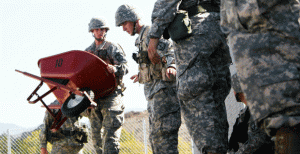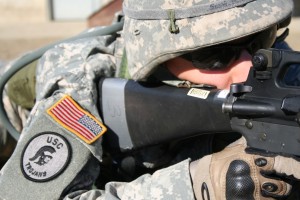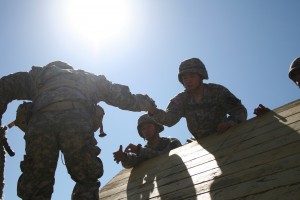USC cadets complete fall Army ROTC training
At 2100 with two hours left on the clock and three given points left to find, a group of USC MS1 cadets on a mission trample through the night with nothing but a compass, pace count, red light and a couple weeks of training to find three out of five small metal poles with a small white placard located more than a mile away from each other. It is their first exposure to what life with the Army Reserve Office Training Corp’s Trojan battalion will be like.

Teamwork · Tyler Tyburski, a junior majoring in international relations, carried a wheelbarrow across a wooden plank during the field leadership reaction course. - Kristy Pyke | Daily Trojan
An MS1 cadet, a first-year member of the Army ROTC program, pulls off to the side to rehydrate while another MS1 redraws their route using the military grid reference system. This is their final test of the night, a chance to show the senior cadets, MS4s, what they have learned. The fall training exercise is not just weekend training, it is a time to set aside the distractions of school and become the leader the U.S. Army expects them to be.
The MS1 cadets, typically freshmen, were not unaccompanied. An MS4 cadet, the equivalent of a senior or a last-year graduate student, accompanied the five MS1 cadets providing them with advice, such as reminding them that hills and uneven terrain alter their pace count and to use a back azimuth, an angular measurement, when they cannot locate the point. The MS4 cadet helped the MS1s locate two of their five points and then let them attempt to find the others on their own. By 2300, the MS1 cadets completed the mission.
The Army ROTC is an officer-commissioning program completed in conjunction with college education. The program either partially or entirely covers the cost of a cadet’s education.
The Army ROTC program is more than just a means to pay for college and preparation for the adversities of combat.
“ROTC is more than the military aspect,” said Maj. Sean Malis, recruiting officer at Cal State Long Beach. “It’s about life lessons and leadership.”
The leadership skills the USC Army ROTC program instills in its MS1, MS2 and MS3 cadets is mostly taught by MS4s. Cadres, army officers in charge of overseeing the entire ROTC, are present, but they only provide support and advice when necessary.
This unique dynamic that arises as students prepare other students to become officers in the Army is integral to the success of the Army ROTC program. The MS1 cadets can more easily relate to the MS4 cadets, who share similar burdens of school work and social life, than the cadre, according to Maj. Donald Hong, an ROTC recruiting officer for Cal State Long Beach and UC Irvine.

MS4 Michael Scott, a senior majoring in computer engineering and computer science, practiced shooting an M16 at 30-meter targets during the Army ROTC Trojan battalion's fall training exercise at Camp San Luis Obispo last weekend. - Kristy Pyke | Daily Trojan
“They are the next step of leaders, they are getting ready to lead soldiers,” Hong said. “They have been through the program and know what success looks like.”
MS4 Cadet Michael Scott, a senior majoring in computer engineering and computer science, said it is important for the MS1 and MS2 cadets to be trained by their fellow cadets because it gives them an opportunity to understand the Army.
“Training MS1 and MS2 cadets allows them to see what we do in ROTC and what their role in the army will be,” Scott said. “We also need to get the cadets to want to be a part of the Army.”
MS4 cadets attempt to strike a balance between practical and engaging training and events, Scott said.
“When we plan training exercises and events we make sure they’re both realistic and fun so that cadets have the skills necessary for combat and have a good experience,” Scott said.
When faced with problems, MS1 cadets are given guidance from MS4 cadets, but they are also given room to discover their own solutions and to experience failing — by not finding three out of five points on their own during night navigation, for example, said MS4 cadet Hannah Stryker, a graduate student studying social work.
“As long as the [MS1 cadets] don’t get lost, it’s a good learning experience,” Stryker said. “We try to be helpful while letting them figure things out themselves.”
The effectiveness of MS4s’ leadership skills stem from having been good followers as MS1, MS2 and MS3 cadets, Stryker said. MS1 cadets notice and respect the MS4 cadets’ leadership.
“From the beginning, their main goal has been to make us future leaders,” said MS1 cadet Kyle Wollner, a freshman majoring in East Asian languages and cultures. “We learn to show respect for them so they’ll show respect for us.”
Wollner said the MS4s’ leadership skills serve as motivation for the MS1s.

Army ROTC cadets use teamwork to complete an obstacle at the field leadership reaction course. - Kristy Pyke | Daily Trojan
“The MS4s makes demands of us and we have to complete these [orders] to show respect to them for the sacrifices they make to prepare us to be good leaders,” Wollner said.
MS1 Cadet Tucker Jones, a freshman majoring in mechanical engineering, said the MS4s have taught him how to effectively select the individual characteristics of team members when completing a task, such as the field leadership reaction course. During FLRC, teams of cadets need to develop and implement a plan to overcome an obstacle and learn to react and adapt to sudden changes in conditions.
“[MS4s] have taught us to take command and utilize everyone, recognizing their strengths and weaknesses, and utilize those to accomplish the task at hand,” Jones said.
After the fall training exercise, the MS1 cadets have become more integrated into the rich framework of the U.S. Army by their fellow MS4 cadets.
“At the end of the day we are not just fighting for us, but for our fathers, grandfathers and great-grandfathers,” Stryker said. “We are all brothers held together by a deep tradition.”
